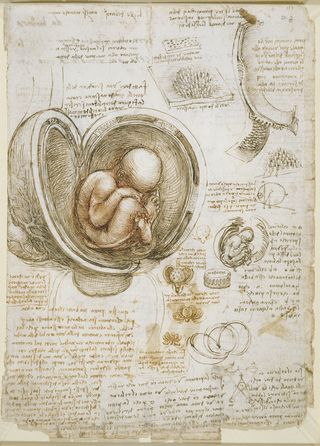Made Detailed Drawings of the Body Based on Dissection
Human Body Function That Stumped Leonardo da Vinci Revealed

Leonardo da Vinci's 500-yr-old illustrations of human being anatomy are uncannily accurate with just one major exception: the female reproductive system.
That's probably because Leonardo had a tough time finding female corpses to dissect, explains Peter Abrahams, a practicing medico at the University of Warwick Medical School in the United kingdom.
Abrahams, a clinical anatomist, has lent his knowledge to an sound bout of the exhibit of Leonardo'due south anatomical drawings that opened May iv in Buckingham Palace.
The Italian Renaissance artist learned anatomy as a manner to improve his drawings of the human course, merely he also brought a scientist'south centre to the bailiwick.
"He wanted to understand how it worked," Abrahams told LiveScience. "He looked at humans similar a mechanic would exercise. Well-nigh of that piece of work is very, very relevant today." [Beefcake Meets Fine art: Da Vinci'due south Drawings]
Anatomists in Leonardo's time often dissected unclaimed bodies, such equally of drunks and vagrants, and those bodies were more than likely to be male, Abrahams said.
"It was definitely harder to get female person bodies to dissect, and he didn't have many opportunities," Abrahams said.
Advances in anatomy
By Leonardo's time, few advances in human anatomy had been made since the second-century work past the Roman anatomist Galen, whose discoveries were largely based on animal dissections. Leonardo da Vinci had the advantage of access to human cadavers.
Abrahams says studying them would have been obnoxious work. "It must accept been horrible, considering they didn't have any form of embalming," he said. "Within 2 or three days that body decomposes."
Leonardo's sketches reveal a deep understanding of how the body worked, much of it however upward-to-engagement. Modern anatomists have only begun in the terminal 60 years to wait at the muscles and tendons of the finger in the item that da Vinci did, Abrahams said. Leonardo was the start to draw the human being spine with the correct curves. He also came tantalizingly close to understanding how blood moved through the body, a mystery that wouldn't be fully solved until 1628, more than than a century afterwards his death.
"In many ways, he was literally 100 years ahead of his time," Abrahams said.
The creative person was likewise the starting time to draw a fetus in utero. Withal, many of his drawings of the female reproductive system get details wrong, Abrahams said. His drawings of the cervix and other female person reproductive organs resembled those of animals more than humans, Abrahams said. [ten Odd Facts About the Female person Body]
"Some of the drawings of the female person pelvis he's tried to extrapolate from animals and not always got it right."
Drawings on display
Leonardo almost certainly planned to publish his anatomical drawings, though he never did. Today the papers are owned by the British Imperial Collection. They're on brandish at the Queen'south Gallery until early October. Beefcake lovers who tin can't get to London have the opportunity to download an iPad app of Leonardo'south drawings.
Today the field of beefcake revolves around new imaging techniques, such as magnetic resonance imaging (MRI) that allows surgeons to meet every detail of a patient's spine before they start operating. Microanatomy, the written report of anatomy on a microscopic level, is besides an area that would accept been out of reach for Leonardo. Just the Florentine artist anticipated advances that would come up simply in the last several decades. His baby-in-utero drawings foresee modernistic ultrasound, Abrahams said, and his drawings of the anatomy of the shoulder look about like modernistic iii-dimensional visualization.
"Much of what he did in the mode he displayed things actually wasn't really physically possible until 30 or 40 years ago," Abrahams said.
You lot tin follow LiveScience senior writer Stephanie Pappas on Twitter @sipappas. Follow LiveScience for the latest in scientific discipline news and discoveries on Twitter @livescience and on Facebook .
Source: https://www.livescience.com/20157-anatomy-drawings-leonardo-da-vinci.html
